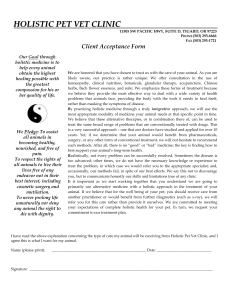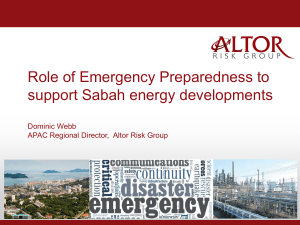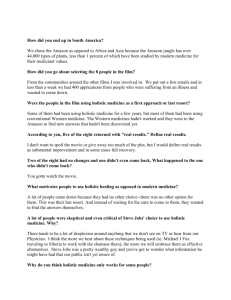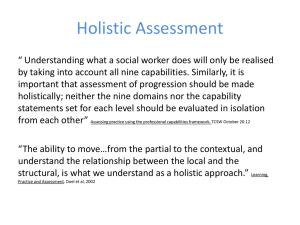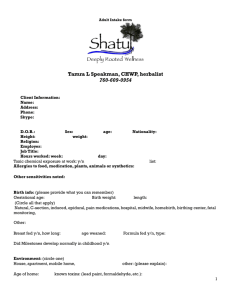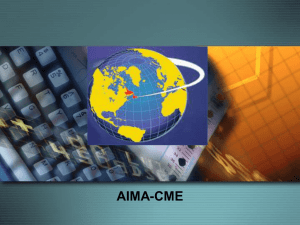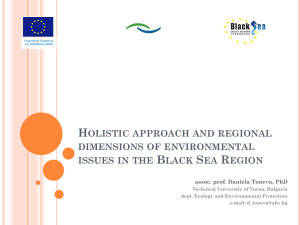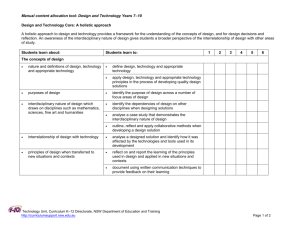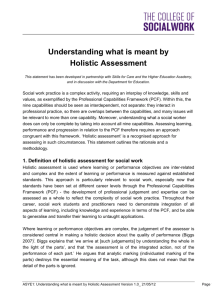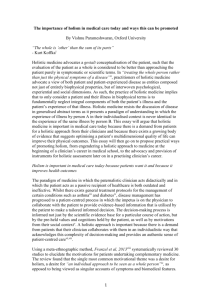Assessment Reconsidered - University of Sheffield
advertisement
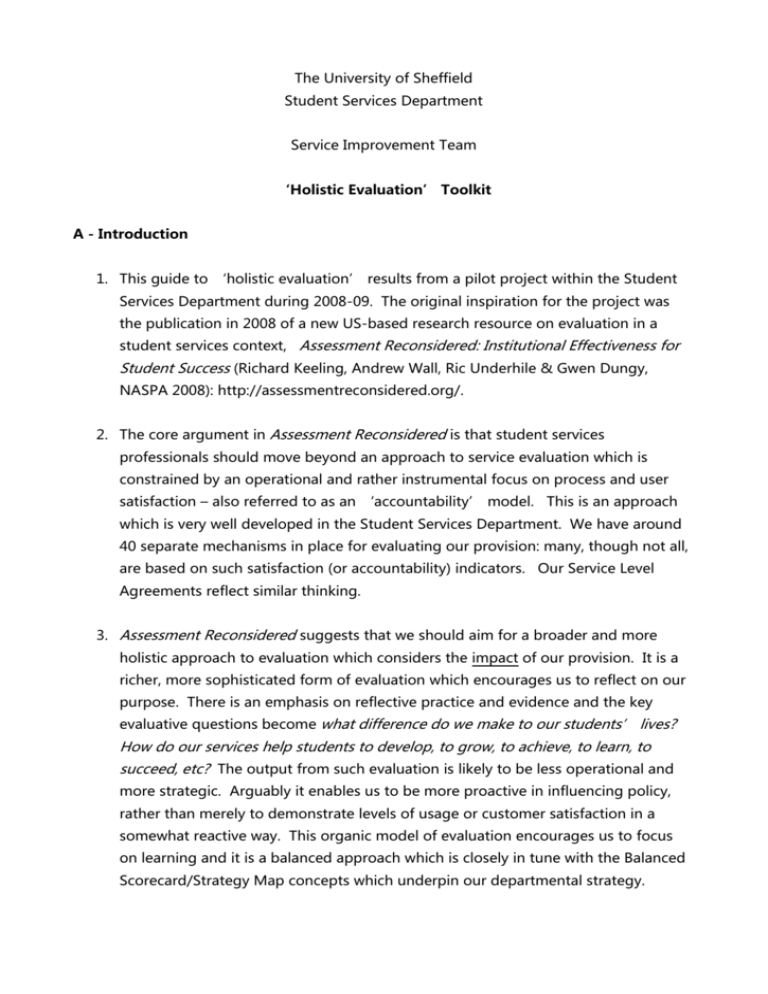
The University of Sheffield Student Services Department Service Improvement Team ‘Holistic Evaluation’ Toolkit A - Introduction 1. This guide to ‘holistic evaluation’ results from a pilot project within the Student Services Department during 2008-09. The original inspiration for the project was the publication in 2008 of a new US-based research resource on evaluation in a student services context, Assessment Reconsidered: Institutional Effectiveness for Student Success (Richard Keeling, Andrew Wall, Ric Underhile & Gwen Dungy, NASPA 2008): http://assessmentreconsidered.org/. 2. The core argument in Assessment Reconsidered is that student services professionals should move beyond an approach to service evaluation which is constrained by an operational and rather instrumental focus on process and user satisfaction – also referred to as an ‘accountability’ model. This is an approach which is very well developed in the Student Services Department. We have around 40 separate mechanisms in place for evaluating our provision: many, though not all, are based on such satisfaction (or accountability) indicators. Our Service Level Agreements reflect similar thinking. 3. Assessment Reconsidered suggests that we should aim for a broader and more holistic approach to evaluation which considers the impact of our provision. It is a richer, more sophisticated form of evaluation which encourages us to reflect on our purpose. There is an emphasis on reflective practice and evidence and the key evaluative questions become what difference do we make to our students’ lives? How do our services help students to develop, to grow, to achieve, to learn, to succeed, etc? The output from such evaluation is likely to be less operational and more strategic. Arguably it enables us to be more proactive in influencing policy, rather than merely to demonstrate levels of usage or customer satisfaction in a somewhat reactive way. This organic model of evaluation encourages us to focus on learning and it is a balanced approach which is closely in tune with the Balanced Scorecard/Strategy Map concepts which underpin our departmental strategy. Holistic evaluation should help us move beyond one-dimensional satisfaction indicators. In short it could be seen to put the ‘values’ back into evaluation. 4. The guidance in this ‘toolkit’ is drawn from the success of four pilots of this broader approach to evaluation which took place in the English Language Teaching Centre, the Disabled Student Support Service, the Counselling Service, and Student Support and Guidance. Guidance is provided on the concept of holistic evaluation (this introductory page); preparing for holistic evaluation; conducting holistic evaluation; and follow up action. Some practical examples - drawn from the pilot projects - are also included. Support for all evaluation activity in the department is available from the Service Improvement Team: http://www.shef.ac.uk/ssd/improvement. Catherine McKeown, c.mckeown@sheffield.ac.uk Andrew West, a.west@sheffield.ac.uk May 2009 aw\directors office\groups\sit\holistic toolkit B - Planning for Holistic Evaluation 1. In determining the scope of evaluation activity, review your existing monitoring and evaluation work. Decide how best – and where - to incorporate a holistic approach. 2. Think about the impact intended by the relevant service/s – this will be the focus of your evaluation. Impact might be expressed in terms of ‘learning outcomes’, for example completing a phrase like ‘at the end of this programme/having participated in this activity/service, students will …’ An alternative is to reflect on the questions referred to in section A above, ie how is this particular activity/programme/service intended to help students to develop, to grow, to achieve, to learn, to succeed, etc. 3. Be clear about why you are conducting this form of evaluation (to assess impact), and think of how best to explain this to service users and other stakeholders (eg colleagues). 4. Consider limiting this form of evaluation to a particular aspect of the service (don’t attempt to do too much!). 5. Identify a manageable group of service users to focus on, but keep in mind the importance of gaining the broadest possible range of views – think about how your evaluation will reflect issues of equality and diversity. 6. In finalising your plans, refer to relevant reference points (eg external/professional standards or best practice, the Sheffield Graduate concept, strategic plans and documents like the Magnificent 8, etc). 7. Share information about the evaluation in advance with other ‘stakeholders’ eg departmental colleagues, staff from academic departments/faculties, the Union of Students and colleagues from other professional services. Get their input and help them understand the benefit of this type of evaluation. 8. Consider the most appropriate point at which to conduct evaluation. It is likely to work best if you have allowed sufficient time for user/student reflection on the service/activity you are evaluating. Example Evaluating the impact on students’ development of participating in ‘Skills for Life’ workshops, run by the Counselling Service. The evaluation was based on a selected group of workshops. It was carried out 3-4 months after the workshop/s had taken place, to allow time for participant reflection on their learning and a chance for participants to practise the tools and techniques covered in the workshop/s. C - Conducting Holistic Evaluation 1. When inviting service users to participate, explain the rationale -have a short statement prepared about why you are conducting this sort of evaluation so that students/users understand the purpose and the likely benefits. 2. Work out an evaluation schedule. Factor in time to issue reminders to students to achieve as high a participation rate as possible. Make sure you have robust contact information for students. Plan for some drop-outs/non-respondents. Remember you will need time to write up/reflect on the output. If you are planning a meeting, think about how you will record the comments (eg a note taker or an electronic recording system). Allow a little more time for flexibility/contingency. 3. This sort of evaluation is likely to work best if you use a range or combination of evaluation methods over time. Some possibilities include: focus group tracking/reference group paper questionnaire on line survey (eg survey monkey) test/assessment 'scientific' instrument set of questions sent by email case study individual or group reflection one-to-one ‘interview’ or structured conversation. 4. It can be helpful to offer more than one method to an individual participant (eg a student may feel happier to provide feedback at a one to one interview rather than a focus group). 5. For any meetings, choose the right location eg familiar surroundings, comfortable atmosphere, refreshments, check that students are happy to be recorded if necessary etc. 6. Get help from your colleagues, eg ask them for help in encouraging student participation, or ask them to help you at focus groups, or to comment on your draft questions, or with the write-up. 7. Consider offering an incentive to student participants, such as a store voucher. 8. Be careful to ask appropriate questions in surveys and focus groups. Some issues to consider include: Be clear in your own mind as to why you are asking particular questions. Consider issues of equality, diversity and cultural differences (non native speakers of English should be considered). In a focus group, have an alternative question ready should respondents not answer initially. A prompt (eg giving an example answer) may help, but be careful not to over-direct participants. Avoid asking multiple questions. Allow time for further/open comments (and provide space for this on written questionnaires and surveys). Allow for reflection time so that respondents do not feel rushed. Evaluation of an experience or support activity that occurred some time ago could mean the student needs time to remember. Also an apparent “after thought” may be an important contribution. Example questions How useful was (the service) in preparing you for… In the light of what you know now, how could we improve (the service)? How have you applied what you learnt through (this service) in your daily life? How has (this service) helped you in your studies? How has (this service) made a difference to… Thinking about everything you experienced in (this service), how has it affected you/impacted on you/helped you/encouraged you/changed you? D - Follow Up 1. When transcribing records of meetings (written or audio), consider extracting the key points and salient quotes rather than producing a verbatim transcript. 2. Reflect on what you have learnt about the effectiveness and impact of the service. Capture any specific feedback you can use in service improvement. Collect some quotations/’sound bites’. 3. Make sure you remember to thank participants and inform them of the summary findings/results of the evaluation and how you intend to use these in service improvement. 4. Consider an announcement to the broader student body, for example using the student survey (‘you said, we did’) webpage: http://www.shef.ac.uk/ssid/news/survey/. 5. Disseminate findings to key stakeholders, as identified during the planning stage. 6. Summarise service improvement actions which have arisen from the evaluation and ensure you have a mechanism for taking these forward. 7. Plan to review the action you have taken after some months. Also think about repeating the evaluation in the future (though probably not very frequently). Some views from colleagues who have already conducted holistic evaluations: “We have gained a real insight (into our service)” “It is great to hear individual stories and not just see tick boxes on an evaluation form” “It was good to hear that students were still benefitting three months on from a relatively short input” “What I have learned will enable me to manage expectations far better”
